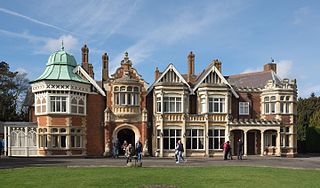
Bletchley Park is an English country house and estate in Bletchley, Milton Keynes (Buckinghamshire), that became the principal centre of Allied code-breaking during the Second World War. The mansion was constructed during the years following 1883 for the financier and politician Herbert Leon in the Victorian Gothic, Tudor and Dutch Baroque styles, on the site of older buildings of the same name.
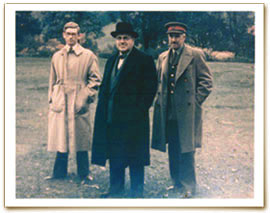
Sir Francis Harry Hinsley, was an English intelligence officer and historian. He worked at Bletchley Park during the Second World War and wrote widely on the history of international relations and British Intelligence during the Second World War. He was known as Harry Hinsley.
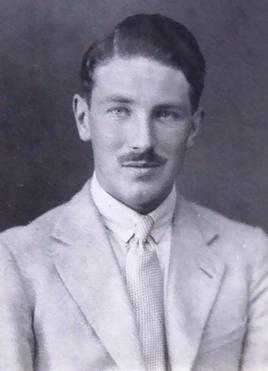
William Gordon Welchman OBE was a British mathematician. During World War II, he worked at Britain's secret decryption centre at Bletchley Park, where he was one of the most important contributors. In 1948, after the war, he moved to the US, and later worked on the design of military communications systems.
Commander Alexander "Alastair" Guthrie Denniston was a Scottish codebreaker in Room 40, deputy head of the Government Code and Cypher School (GC&CS) and hockey player. Denniston was appointed operational head of GC&CS in 1919 and remained so until February 1942.

Hut 6 was a wartime section of the Government Code and Cypher School (GC&CS) at Bletchley Park, Buckinghamshire, Britain, tasked with the solution of German Army and Air Force Enigma machine cyphers. Hut 8, by contrast, attacked Naval Enigma. Hut 6 was established at the initiative of Gordon Welchman, and was run initially by Welchman and fellow Cambridge mathematician John Jeffreys.

John Robert Fisher Jeffreys was a British mathematician and World War II codebreaker.
Hut 7 was a wartime section of the Government Code and Cypher School (GC&CS) at Bletchley Park tasked with the solution of Japanese naval codes such as JN4, JN11, JN40, and JN-25. The hut was headed by Hugh Foss who reported to Frank Birch, the head of Bletchley's Naval section.

Jean Millar Valentine, laterJean Millar Rooke was an operator of the bombe decryption device in Hut 11 at Bletchley Park in England, designed by Alan Turing and others during World War II. She was a member of the "Wrens".
Mavis Lilian Batey, MBE, was a British code-breaker during World War II. She was one of the leading female codebreakers at Bletchley Park.
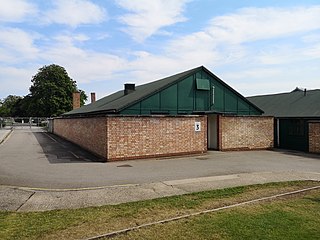
Hut 3 was a section of the Government Code and Cypher School (GC&CS) at Bletchley Park during World War II. It retained the name for its functions when it moved into Block D. It produced military intelligence codenamed Ultra from the decrypts of Enigma, Tunny and multiple other sources. Hut 3 thus became an intelligence agency in its own right, providing information of great strategic value, but rarely of operational use. Group Captain Eric Malcolm Jones led this activity from 1943 and after the war became deputy director, and in 1952 director of GCHQ. In July 1945, General Dwight D. Eisenhower Supreme Commander of Allied forces wrote to Sir Stewart Menzies, Chief of the British Secret Intelligence Service (MI6) saying inter alia:
"The intelligence that has emanated from you before and during this campaign has been of priceless value to me. It has simplified my task as commander enormously. It has saved thousands of British and American lives and, in no small way, has contributed to the speed with which the enemy was routed and eventually forced to surrender."
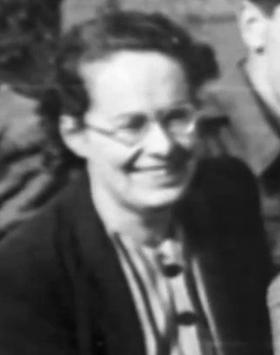
Joan Elisabeth Lowther Murray, MBE was an English cryptanalyst and numismatist who worked as a code-breaker at Bletchley Park during the Second World War. Although she did not personally seek the spotlight, her role in the Enigma project that decrypted the German secret communications earned her awards and citations, such as appointment as a Member of the Order of the British Empire (MBE), in 1946.
Mair Russell-Jones, born Mair Eluned Thomas, was a graduate in Music and German from Cardiff University who during the Second World War worked as a civilian codebreaker for the Government Code and Cypher School at Bletchley Park. She worked in Hut 6, decrypting messages in Enigma machine cipher.
Charlotte Elizabeth Webb is an English code breaker who worked at Bletchley Park during World War II at the age of 18. Starting in 1941 she joined the British Auxiliary Territorial Service. She said, of joining the top-secret mission at Bletchley, "I wanted to do something more for the war effort than bake sausage rolls."
Michael Arbuthnot Ashcroft (1920–1949) was a code breaker at Bletchley Park during the Second World War, working in Hut 8 under Alan Turing.
Ann Katharine Mitchell was a British cryptanalyst and psychologist who worked on decrypting messages encoded in the German Enigma cypher at Bletchley Park during the Second World War. After the war she became a marriage guidance counsellor, then studied for a Master of Philosophy at the University of Edinburgh. She worked at the university's Department of Social Administration and wrote several academic books about the psychological effects of divorce on children, including Someone to Turn to: Experiences of Help Before Divorce (1981) and Children in the Middle: Living Through Divorce (1985).

About 7,500 women worked in Bletchley Park, the central site for British cryptanalysts during World War II. Women constituted roughly 75% of the workforce there. While women were overwhelmingly under-represented in high-level work such as cryptanalysis, they were employed in large numbers in other important areas, including as operators of cryptographic and communications machinery, translators of Axis documents, traffic analysts, clerical workers, and more. Women made up the majority of Bletchley Park’s workforce, most enlisted in the Women’s Royal Naval Service, WRNS, nicknamed the Wrens.

Irene Jessie "Mouse" Brown was an author and codebreaker who worked at Bletchley Park in Buckinghamshire in Hut 6 during the Second World War. She was employed as a linguist and translator working in the Registration Room and the main Decoding Room.

Ailsa Giles Maxwell was a British Bletchley Park code breaker and historian.











